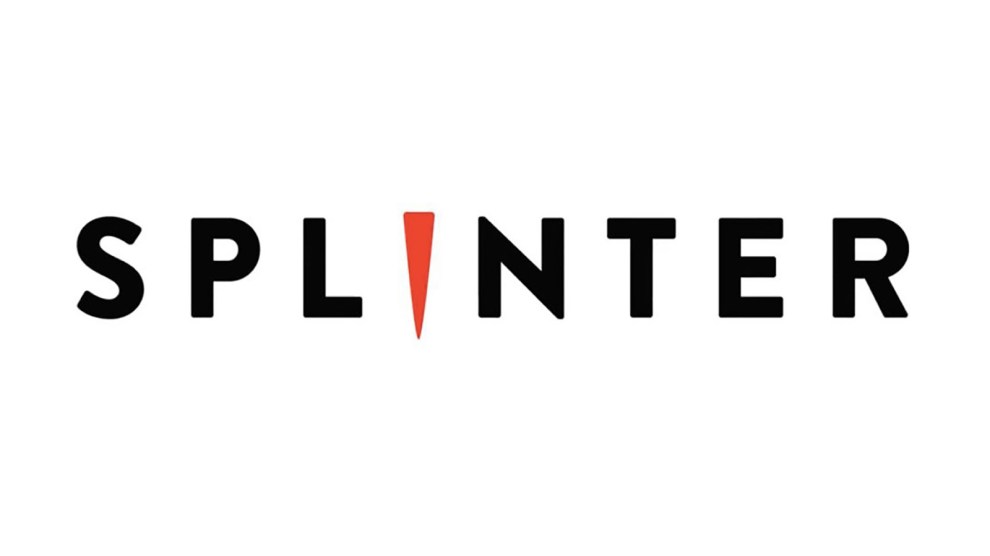Over the past four decades, private equity has become a powerful, and malignant, force in our daily lives. In our May+June 2022 issue, Mother Jones investigates the vulture capitalists chewing up and spitting out American businesses, the politicians enabling them, and the everyday people fighting back. Find the full package here.
Early in March of 2021, Anh-Thu Nguyen called her Brooklyn landlord to add a new housemate to her lease. It was a mundane request, one that the 39-year-old labor organizer had made a handful of times since moving into her three-bedroom apartment in Park Slope on the heels of the last financial crisis.
Nguyen’s home is on the second floor of a prewar building directly across from one of the borough’s largest parks and surrounded by houses worth between $3 million and $5 million. The spot had become a financial refuge for Nguyen and various roommates over the years—creatives, advocates, and other strivers like her whose salaries didn’t keep pace with the city’s soaring cost of living, but who could afford to stay by living there together.
For more articles read aloud: download the Audm iPhone app.
For a couple of weeks, Nguyen’s landlord avoided her calls and emails. Then someone slipped a letter under her door stating that their building was under new management. When she dialed the number on the letter, the person who picked up—someone named TJ—told her that he represented the new landlord, and they were refusing her housemate request. It didn’t make sense to add someone now, he said, because the new owners—a mysterious LLC named after the building’s address—wouldn’t be renewing their lease, even though the housemates had never once missed a rent payment or caused any trouble. A written notice came by email the same day. They had 90 days to vacate the premises.
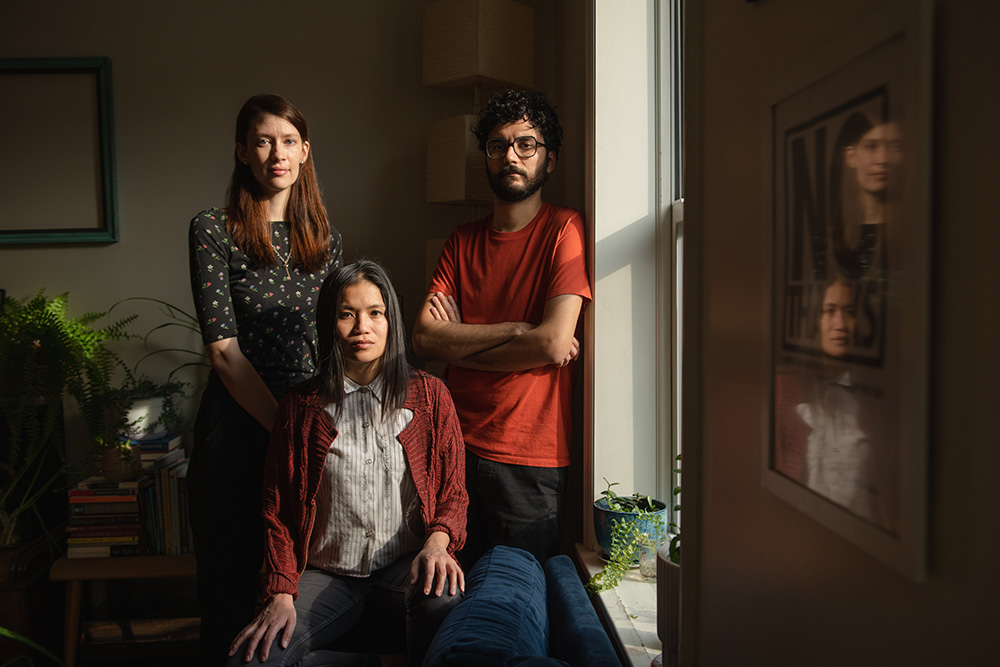
Anh-Thu Nguyen, Alfonso Solis and Emily Parent at their apartment in 70 Prospect Park West. Nguyen moved to the apartment in November 2009, Parent moved in August 2018 and Solis joined April 2021.
Kholood Eid
It was the one-year anniversary of the pandemic’s start in New York City—one year since panicked shoppers emptied grocery shelves of basic supplies and the shock of silence pierced by ambulance sirens overtook the city’s soundscape. The coronavirus was once again raging in New York, and eviction protections remained active. While this was not technically an eviction, it would amount to the same thing: displacement in the middle of a pandemic.
All of this—the appearance of a new corporate landlord and the abrupt end of Nguyen’s lease—was part of a shift that extended far beyond her apartment walls, and even her building. As Covid held Americans hostage, the nation’s private equity investors were trying to capitalize on the distressed New York City real estate market. The same cruelty that awakens after every financial crisis had reappeared: Everyday people suffer while a select world of financiers use the crash to acquire greater wealth.
Nguyen knew none of this yet. But she did know that she didn’t want to leave her home at 70 Prospect Park West. So she did what she’d been trained to do in law school and during her decade of working with employee co-ops and labor advocates: She researched, compiled information, and then hollered from every possible platform until somebody finally listened.
The written notice that Nguyen received in March 2021 was signed by a man named Fred LeCao. She took to Google and figured out that LeCao worked in real estate investing at BlackRock during the 2008 financial crisis, when the mammoth investment firm cashed in on the deluge of foreclosures that engulfed millions of families during the Great Recession by buying up bad mortgages on the cheap using the government’s money, and then waiting for those investments to appreciate. Now, LeCao was a principal at a Manhattan investment firm called Greenbrook Partners—a self-described “vertically integrated real estate operating company” that seeks to “maximize value” by “redeveloping properties” in New York City—and more and more of Nguyen’s neighbors in the building were getting notices from him.
It didn’t take long to piece together the rest: Greenbrook—with funding from a private equity real estate investment firm called NW1—had bought their building and had plans to turn a tidy profit by converting their homes into upscale rentals as the pandemic boiled over. Their previous landlords hadn’t done much to make the building especially luxurious, but it was decent and they’d kept the rents mostly below market, often going years without an increase: Nguyen and her housemates paid $3,350 for a three-bedroom place, only $150 more than the rent when Nguyen arrived in 2009, and a steal in a neighborhood where luxury three-bedrooms can rent for more than $6,000. This made their building a prime target for investors. “They’re pushing people out and jacking up the rent,” Nguyen told her neighbors at a building-wide meeting in June. NW1 had pitched its plan with a more elaborate spin: The company planned to “form a programmatic joint venture…to acquire walk-up, brownstone multifamily properties in Brooklyn’s most in-demand neighborhoods, capitalizing on the area’s attractive demographic trends.”
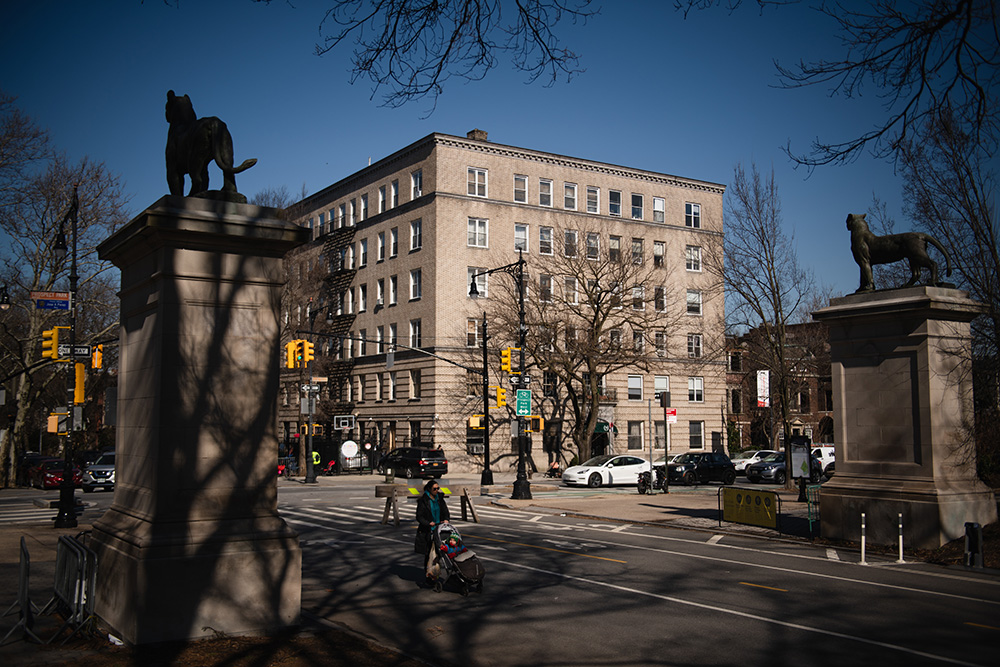
70 Prospect Park West sits at one of the entrances to the park in Brooklyn.
Kholood Eid
Nguyen, her housemates, and some of their neighbors commenced a full-on research operation. They suspected that if this was happening to their building, it must be happening elsewhere, too. Pretty soon their sleuthing through real estate records revealed that Greenbrook had purchased at least 52 Brooklyn apartment buildings, 34 since the pandemic began. (As of this writing, those numbers have risen to at least 111 buildings and as many as 146, with the exact total obscured by the opaque ownership structures of some of the LLCs used to purchase the properties.) The neighbors meticulously documented each one in a spreadsheet so detailed that an early version contained the latitude and longitude of the buildings, which were clustered in two areas of Brooklyn: Bushwick, a majority-Latino neighborhood where rising rents have been pushing out longtime residents for years, and their own neighborhood, Park Slope, a swishy stroller enclave with eye-popping home prices thanks to 30-plus years of gentrification. (Sen. Chuck Schumer lives just a few blocks away from Nguyen’s building.) This, along with New York City property records, suggested a two-pronged investment strategy: One part targeted undervalued homes in ritzy neighborhoods, and the other would take active part in gentrifying areas adjacent to brownstone Brooklyn.
A handful of the tenants started knocking on doors and handing out flyers: “Your building was sold to the same developers…who recently bought our building,” they read. “We are fighting back.” As they met more and more tenants, the residents of 70 Prospect Park West, or 70 PPW, found out that Greenbrook had refused to renew leases across many of its purchased buildings, and that hundreds of tenants had already vacated during the pandemic, unaware that they might be able to fight back. They also figured out from New York property records that Greenbrook had secured some major partners: On at least 36 of its properties, it held mortgages in collaboration with Carlyle, one of the nation’s largest private equity firms. Meanwhile, Greenbrook’s flipping strategy was already making money: Within a month of one household’s exit at 70 PPW, their three-bedroom had been spruced up and rented for $7,595 per month, according to its listing on the local website StreetEasy—nearly double the previous rent. (The Carlyle Group did not respond to requests for comment.)
The tenants’ question remained, though: Who was Greenbrook making this money for? They had pieced together that private equity firm NW1 was bankrolling some of Greenbrook’s pandemic buying spree. But private equity funds invest other people’s money: Their investors are typically large institutions, like pension funds or university endowments. So who was the source of all this cash?
The full answer is still unclear. But as Nguyen dug through obscure real estate trade publications, she came across an article that mentioned that NW1 had raised $100 million from an unnamed US investor. NW1’s co-founder called the money a “catalyst” for his young firm, which was founded in 2016 and previously had only about $300 million under management, according to federal disclosures. Another article identified the mystery investor. It was the Texas Permanent School Fund (TPSF), a $50 billion portfolio overseen by the state’s board of education to finance the state’s public school infrastructure. It also happens to be one of the largest sovereign wealth funds in the United States.
The discovery brought the situation at 70 PPW into sharp relief: The pressing public education needs of Texas were being pitted against the pressing housing needs of middle-class Brooklynites. The financiers who had engineered these real estate deals, however, had a stake in neither. They had little to lose and so much to gain.
On a Zoom call in June, a consultant hired to evaluate the Texas school board’s portfolio could not stop gushing about the fund’s private equity investments. Other holdings had faltered in the pandemic-battered economy, but private equity had been the fund’s “boon”—“the real star.” The TPSF’s portfolio was up 29 percent, to nearly $50 billion. “It is generating just gobs of excess return,” he told a conference room full of people in Austin. “Really, private equity has been your home run.”
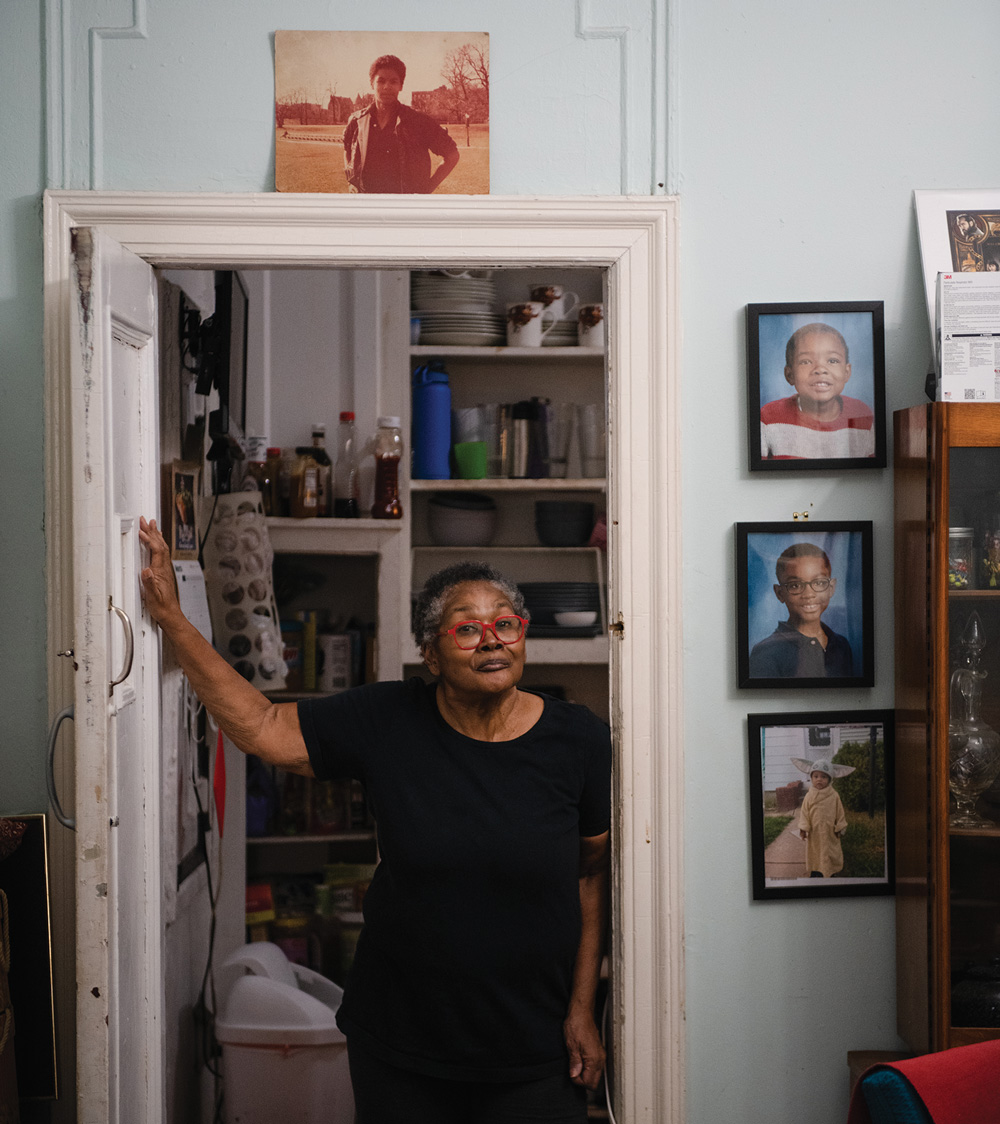
Denise Alexander moved to 70 PPW in the late 1970s and raised three children there.
Kholood Eid
The audience in the room—which included six members of the Texas State Board of Education—mostly nodded quietly along with his presentation as he pointed to charts and rattled off numbers, his patter dotted with enthusiastic finance-speak.
Over the prior several weeks, the board members had been inundated with letters from tenants in New York City about exactly this private equity strategy, begging them to disinvest from Greenbrook. “We’re alarmed that the Texas public school system is being funded through the mass eviction of tenants in Brooklyn,” wrote one pair of tenants to Tom Maynard, chair of the school board committee overseeing the TPSF. “Greenbrook has already caused significant harm in the midst of a pandemic and your board has the ability to stop them from further uprooting people’s lives.”
The next day, a few concerned members asked the board to discuss what was happening in Brooklyn. Aicha Davis, who represents the Dallas–Fort Worth area, was one of them. “I understand that in some kind of way, we invest in one company that’s funneling the money to another company that’s taking away multifamily housing units,” she said. “We don’t want to take homes away from anybody.” Two other members also tried to sway their colleagues. “Couldn’t we look around for some other kind of investment that doesn’t give us the reputation of benefiting from the misfortune of people in a community far away from us?” asked Rebecca Bell-Metereau of San Marcos, while Ruben Cortez Jr. of Brownsville called on the board to stop financing “predatory rental practices.”
But the investment advisers at the meeting assured the board that this framing was all wrong. What they were doing was typical for the real estate business—and actually helping people. “It is absolutely not predatory,” said Steve Novick of the private equity firm StepStone Real Estate Group, which had been hired to consult for the TPSF on its real estate investments. “The business strategy is not in any way to evict anyone. It is to improve the quality of living for renters in New York City.” (StepStone Group declined to comment for this story.)
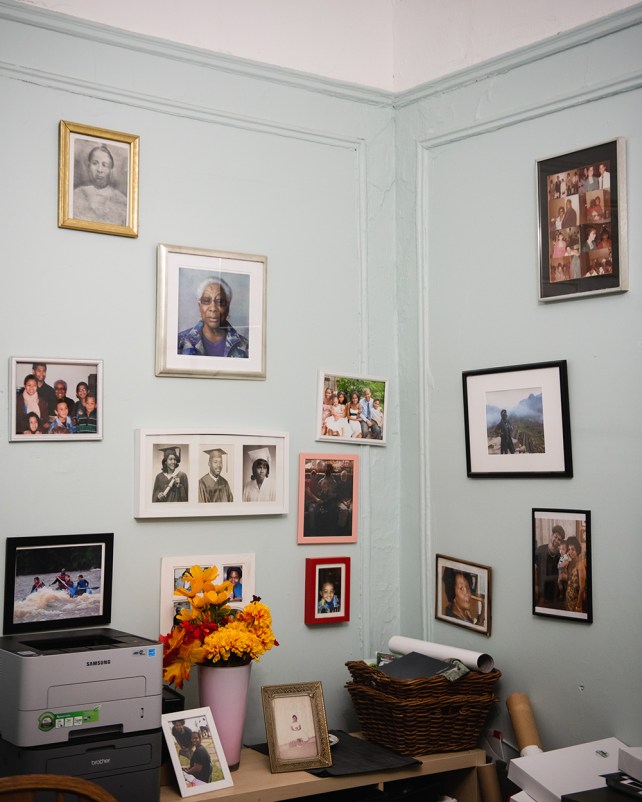
Denise Alexander’s family photos in her apartment. Alexander has lived in her unit for 45 years.
Kholood Eid
Back in Brooklyn, the quality of living for Greenbrook’s tenants had not improved. During construction ordered by Greenbrook to flip the apartment directly above Nguyen’s, the ceiling in her shower collapsed, just minutes after her housemate had used it. (There’d been a long-standing leak that the previous landlord had patched, and Greenbrook had ignored warnings from Nguyen and her housemates that the upstairs construction had exacerbated the problem.) In another Greenbrook building, the firm commenced simultaneous renovations on nearly half of the building’s units, stirring up so much construction dust that tenants wore masks in common spaces. One tenant with asthma was hospitalized for four days from the pollution, according to a summary from local lawmakers. A couple with a newborn found themselves in another Greenbrook property without heat and hot water after the new landlord began demolition to renovate the unit above theirs. Other tenants in Greenbrook buildings filed reports with the local buildings department about contractors disposing of debris from a fire escape, leaving it in common spaces, and doing noisy construction without permits during prohibited hours.
At 70 PPW, as with many all-renter buildings in coveted NYC neighborhoods, tenants and their old landlords had struck a delicate balance: The tenants humored some maintenance delays and inefficiency in exchange for below-market rent on solid homes in an unbeatable location. Greenbrook upended this arrangement by not only trying to kick tenants out but also beginning construction projects, seemingly unconcerned with disturbing them.
At Nguyen’s direction, the tenants of 70 Prospect Park West expanded their counterattack. They managed to get the attention of Brad Lander, their district’s representative on the city council and a longtime tenants’ rights advocate. (Lander was later elected to serve as New York’s comptroller in November 2021.)
Council member Lander’s office—in cooperation with a member of the New York State Assembly and a member of the city council in Austin, Texas—put together a 12-page memo outlining Greenbrook and NW1’s strategy in plain language. They compiled the findings of the 70 PPW tenants, who by now had identified 54 Greenbrook buildings with more than 1,000 tenants. The officials contacted tenants in a dozen of those buildings. “In every case, the story is the same,” they wrote. “Greenbrook’s business model is to evict rent-paying tenants from their homes.” They surmised that Greenbrook and NW1’s profit motive revolved around the pandemic: The firm seemed to be trying to buy up as many multifamily buildings as possible, just as the rental market was set to rebound upon the reversal of New York’s Covid exodus.
The council members sent their memo to the Texas Permanent School Fund, and asked the fund to divest from NW1 and Greenbrook, “to stop the financing of a business model premised on mass eviction,” they wrote. “The evictions are not an unfortunate side-effect of their strategy; they are the fundamental logic that drives it.” On the same day, Lander joined tenants of 70 PPW for a rally outside their building to formally launch the push for Texas to divest.
The suggestion that Texas pull its $100 million investment caught the attention of David Boyle, NW1’s managing partner. A few days later, Boyle sent Lander an email.
“Dear Councilman Lander,” he wrote. “I am the son of two career social workers in New York. I am certainly not out to hurt anybody, but simply improve the quality of rundown housing with poor infrastructure in your district to make better living experiences for families.” He explained that Park Slope housing conditions were often slipshod, left to deteriorate by absentee owners. His firm had purchased “free market units,” and their investment would improve buildings’ environmental efficiency, not to mention subsidize lower rents for those who “truly” could not afford to stay otherwise. “There is no free lunch—we need to invest for progress and to help the truly less fortunate.”
At their meeting a couple of weeks later, the 70 PPW tenants were incredulous. Park Slope is one of the most coveted neighborhoods in Brooklyn, and their building—with its marble accents, tall ceilings, and a chandelier in the lobby—is far from the hovel Boyle seemed to be implying he’d so charitably invested in.
“He’s basically saying that they’re taking properties that are neglected, and that through the process of basically evicting some of us they’re subsidizing rent-controlled units and helping the truly needy?” said one tenant, trying to suppress a chuckle. “That doesn’t make any sense.” (Eight units at 70 PPW are protected by a city program that limits rent hikes. Greenbrook has not asked those rent-stabilized tenants to leave, though it has attempted to force out stabilized tenants in other buildings.)
Boyle made no such claims in comments about his plans to the press. There was no mention of public service or affordable housing. Rather, the goal for Texas’ $100 million investment was to pursue profitable “opportunities” arising from “Covid-19 induced market distress.” In partnership with Greenbrook, he said, NW1 would pour $25 million of that money into Brooklyn apartment buildings, in anticipation that they would eventually soar to $150 million in value—a 500 percent gain to be shared among all parties.
When Nguyen stumbled across Boyle’s statement during her research, the plainspokenness of his description made a lasting impression. “I’m amazed by how brazen it is, and that this is happening in plain sight,” she says. “You don’t know what you don’t know—until it happens to you.”
In the decade since the Great Recession, residential real estate has proved a dependable place for corporate investors, including private equity firms, to make money. Lots of money. Private equity’s selling point is the ability to generate returns that top those earned in the stock market. Usually for investors, chasing greater returns means shouldering greater risk. But for private equity, real estate has become something of an exception to that rule—a reliable source of strong gains, and precisely the sort of low-risk, high-reward opportunity prized by underfunded pension plans and government-owned funds like the TPSF.
This trend has come to be known as “the financialization of housing”—the transformation of housing from a social good into a wealth vehicle for investors, not just individual households. That shift began when the federal government sought to contend with the fallout from the Great Recession. By 2010, millions of people had lost their homes to foreclosure. There were empty houses galore, but too few families who could afford to buy them in a still-flailing economy. So the government turned to a different kind of homebuyer. In 2012, the Federal Housing Finance Agency launched a program that made it possible for corporate investors, like private equity firms, to buy up foreclosed homes in bundles and on the cheap, and then rent them out.
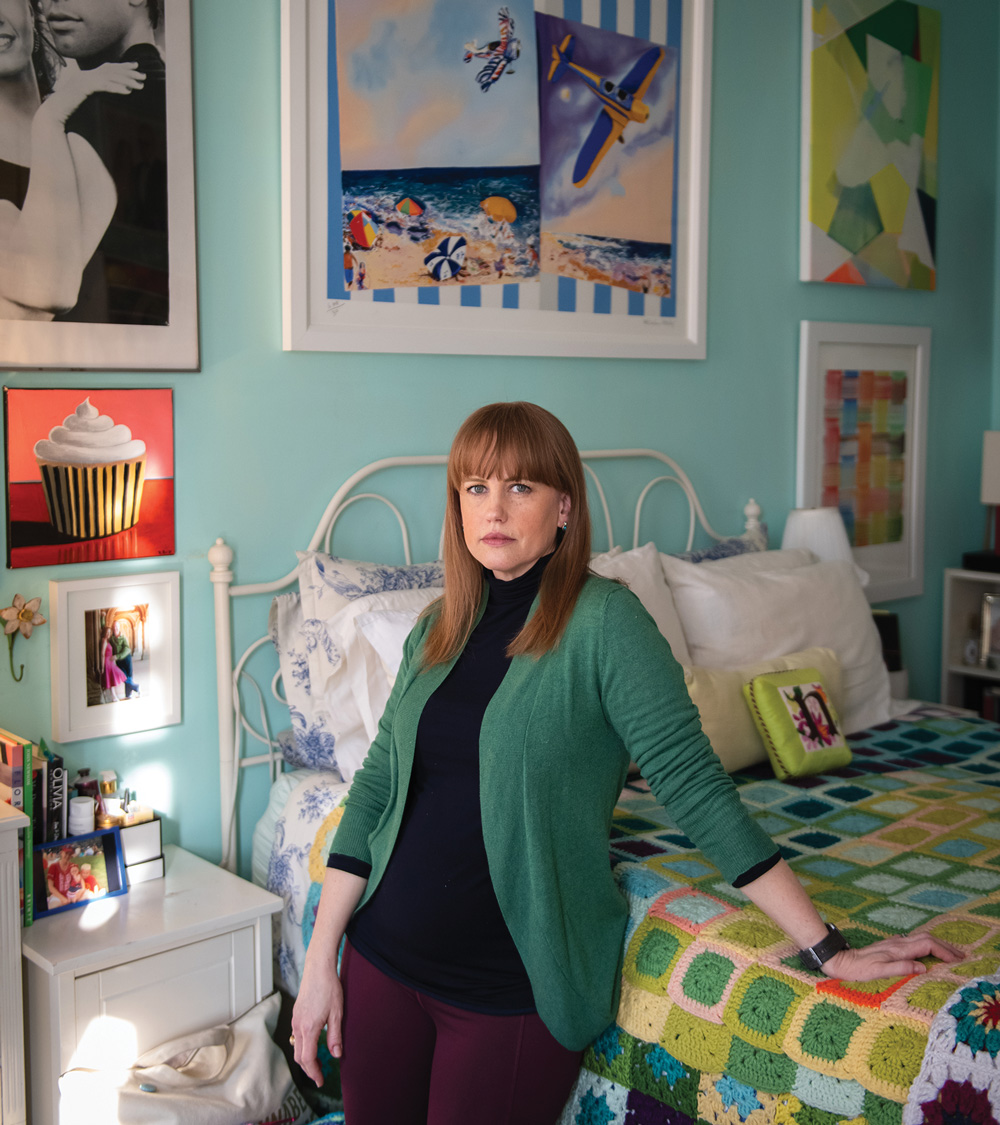
Cassie Newsom was pregnant with her first child when she moved into her unit in 2010.
Kholood Eid
By 2017, according to the Atlantic, hedge funds and private equity firms had spent $36 billion on single-family homes and become a key class of landlord in a number of metro areas that had been hit particularly hard by foreclosures. A study from real estate investment firm Amherst Capital found that before the financial crisis, institutional investors were buying a minuscule share of single-family homes; by 2016, they were involved in at least 7 percent of those purchases. The result was that 25 big firms together owned nearly 220,000 single-family homes—about 2 percent of the market. But not long after this buy-up, America found itself with the opposite problem: As the economy recovered, more people wanted to buy a dwindling number of single-family homes.
The lack of inventory drove up home prices, putting homeownership out of touch for many and ushering in a growing pool of renters and rising rents. In short, private investors helped create a housing problem, and then monetized the consequences, investing at least $580 billion by 2017 into multifamily rentals, mostly apartment buildings, and capitalizing on rising rents by raking in an average annual return of nearly 10 percent on those investments—far higher than that delivered by any other class of commercial real estate.
Now, as the Covid recovery has arrived, history is repeating itself. Two years into the pandemic, private equity firms worldwide hold $377 billion in cash reserves intended for real estate investments; private equity giant Blackstone alone raised $8 billion before the end of 2020. This money now stands ready to pour into pandemic-hit real estate, in what one prominent real estate investor described to the Wall Street Journal as “one of the greatest buying opportunities of the century” for investors. And much like a decade ago, some of this cash is going toward buying up single-family homes, making those houses ever less affordable for most families—and adding to a ballooning community of renters.
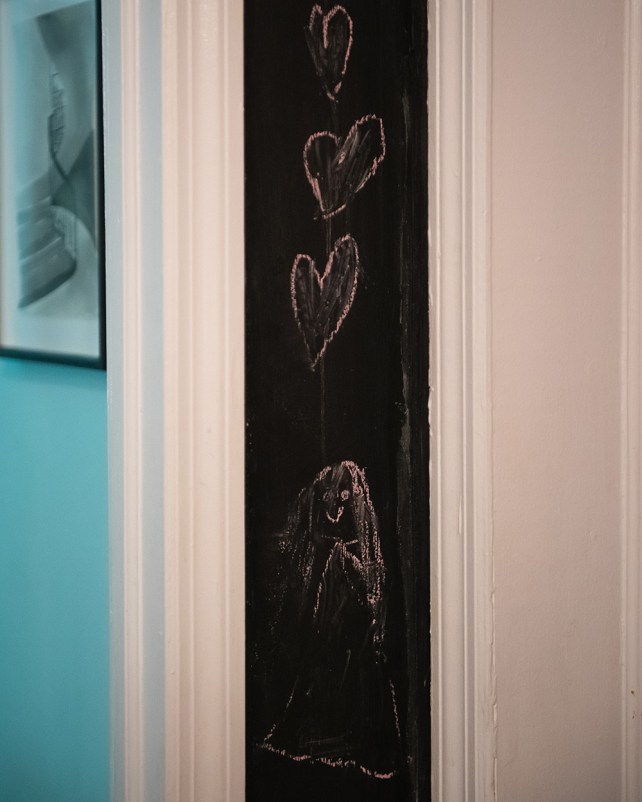
A drawing Cassie Newsom’s daughter, Ruby, 6, made on their chalk wall.
Kholood Eid
So institutional investors are once again betting that rents will soar higher: In the second quarter of 2021, they spent $60.4 billion on multifamily residences, a record high. Among the most prolific apartment purchasers in the last year was Blackstone, which gained notoriety after the last financial crisis as the largest owner of single-family rentals. In Brooklyn, the all-too-familiar mix of inaccessible homeownership and rising rents is exactly why NW1’s Boyle believes that his partnership with Greenbrook will turn a major profit: “We’re seeing a lot of demand for these properties,” he told a reporter in December 2020, three months before purchasing 70 PPW. “They like the neighborhood, but it is still very expensive to buy there, so they rent for longer.”
As the tenants of 70 PPW continued their advocacy, they uncovered another key element of Greenbrook and NW1’s strategy: While the firms’ main efforts seemed to focus on kicking out market-rate tenants, they’d also begun trying to oust residents of rent-stabilized apartments, who can only be asked to leave for a limited list of violations. Yet Greenbrook was simply pushing them out, without cause.
Nguyen and her neighbors discovered this in a lawsuit filed by the city’s Department of Housing Preservation and Development against Greenbrook in late 2020, accusing it of harassing rent-stabilized tenants in other buildings with buyout offers, noisy construction, and a failure to fix health and safety violations.
According to the lawsuit, the Greenbrook buildings had mice and cockroach infestations, crumbling ceiling plaster, exposed electrical wiring, overflowing trash cans, and missing smoke and carbon monoxide detectors. In violation of state law, McNam Management—the Greenbrook subsidiary tasked with overseeing most of the newly acquired apartments—informed that building’s two rent-stabilized tenants that it would not be renewing their leases, and in the same breath assured them that they’d be able to get a good deal on rent elsewhere: “The winter months provide an opportunity to rent apartments at discounted pricing,” McNam wrote, adding, “We will begin heavy construction work in the coming weeks and work will continue for the next 12-18 months.”
When one of the tenants asked for more clarity on the construction, McNam replied that the building would get a “full gut renovation with construction crews doing demolition work starting at 8 a.m.” In a document filed in the case, one of the two tenants described what came after: “Landlords have carried on extensive construction beginning at early hours, and with no attempt to limit noise and disruption.” By 2022, there were at least 1,092 open housing code violations across Greenbrook’s building portfolio, almost double the citywide average for this number of units.
The city’s lawsuit also alleged that there was a calculus behind Greenbrook’s actions: a loophole in New York’s strict tenant laws called the “Substantial Rehabilitation” rule. Under this provision, landlords can permanently remove apartments from rent stabilization protections—and hike rents without limit—by renovating a property, as long as the building was “seriously deteriorated” and at least 80 percent vacant when the construction process began. Hence Greenbrook’s push to oust a majority of the tenants. (Greenbrook and its partner NW1 did not respond to multiple requests for comment. McNam Management also did not respond to comment requests.)
In one building, according to Lander’s memo, someone from Greenbrook told one tenant as much directly, saying their plan was to bring the occupancy under 20 percent so as to eliminate the building’s renter protections. In another building, Greenbrook sent all the tenants notices of lease nonrenewal, despite the fact that the entire building is rent-stabilized. Many of the tenants simply left, unaware of their rights. “Every single building that we found tenants in has this pattern taking place,” said Lander of Greenbrook’s efforts to oust a majority of tenants. “This is not incidental. This is their business model.”
Last August, Aicha Davis, the Texas Board of Education member, decided it was time to travel to Brooklyn to see what was happening for herself. In their meetings over the summer, Davis, a teacher from Dallas, has been one of the voices who repeatedly expressed concern about what their investment was doing in Brooklyn. Throughout, TPSF advisers and staff had given her the impression that the buildings were neglected, and that only a few buildings—where well-off tenants had grown disgruntled at the prospect of paying “a little” more rent—were affected.
It was Davis’ first time in New York City. When she got to Brooklyn, she was stunned at the gaps between what she saw and the descriptions she’d heard back in Austin.
The tenants in the five buildings she visited were not the wealthy New Yorkers she’d been told to expect: “It wasn’t the superrich folks who just didn’t want to pay a little bit more,” she says. “These were teachers and school counselors and folks who just graduated from college.”
Even more surprising, the buildings she visited didn’t seem neglected at all. “I had been advised that these buildings were in horrible condition. They needed a ton of work.” Instead, she found that the units looked just fine. “It wasn’t anything to the point where a whole renovation has to happen,” she says. “I was shocked.” In September, a handful of Greenbrook’s Brooklyn tenants testified at the Texas Board of Education’s fall meeting. They reiterated what Davis had seen: Their buildings were just fine before Greenbrook arrived. What they needed most was simply the right to stay in their homes. Once again, they implored the TPSF to divest its $100 million from NW1 and Greenbrook. (The TPSF did not respond to requests for comment about Davis’ characterization, or about their most recent stance on withdrawal of their investment.) When that didn’t work, the tenants kept going. With the help of Lander’s office, they had gotten their cause on the radar of their prominent neighbor, Sen. Schumer, who spoke at a rally in front of 70 PPW in October. “There is nothing more despicable than these predatory real estate equity firms trying to make…billions of dollars on the backs of tenants,” he said, flanked by dozens of cheering advocates, state lawmakers, and tenants from Greenbrook buildings all around Brooklyn.
Four months after the rally, Nguyen got the chance to address senators from the Committee on Banking, Housing, and Urban Affairs. She blamed Greenbrook, Carlyle, and their fellow private equity firms for worsening housing unaffordability across the country, amid the twin crises of a housing shortage and a pandemic. At a full committee hearing two days later, another Greenbrook tenant testified, and several Democratic senators gave passionate speeches echoing their concerns.
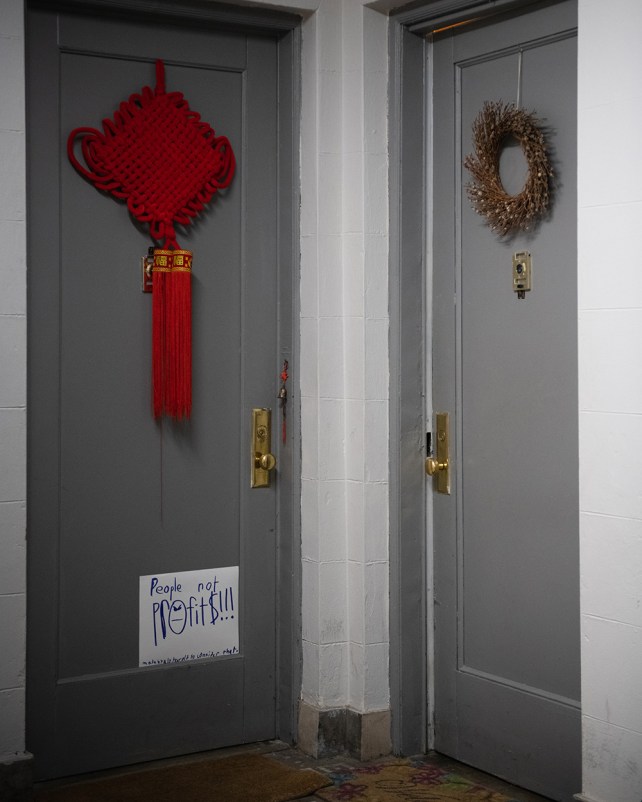
Anh-Thu Nguyen, Alfonso Solis and Emily Parent’s apartment in 70 Prospect Park West.
Kholood Eid
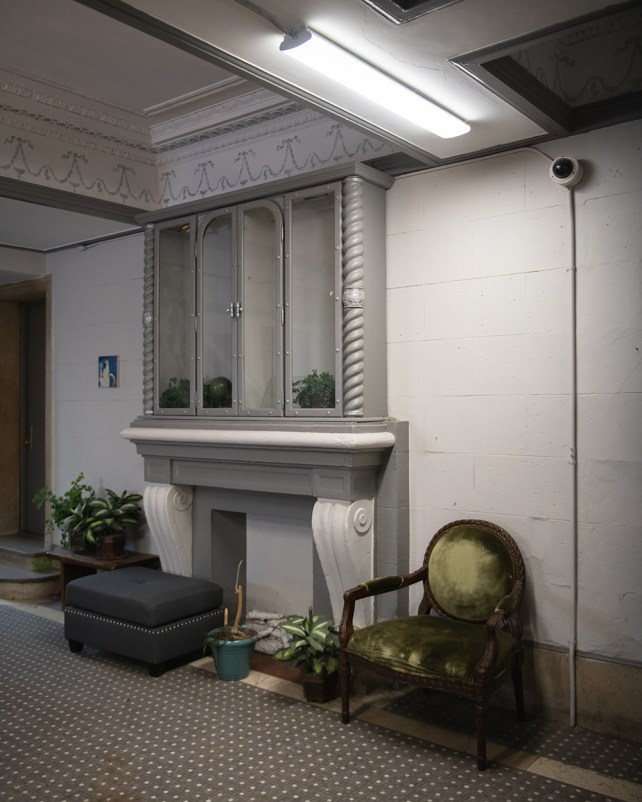
70 Prospect Park West.
Kholood Eid
But all this talk has, for now, done little to change the day-to-day reality for hundreds of Greenbrook tenants, including the residents of 70 PPW. A year has passed since the original deadline by which Nguyen and her neighbors were supposed to have vacated their apartments. Some have buckled and left, but 10 are still there, still juggling the demands of their lives—full-time jobs, parenting, family illnesses—with the stress of living on contested territory. Those 10 remaining tenants have sued Greenbrook executives, and each month Nguyen mails her rent check, but the checks haven’t been cashed—a tactic the firm could use to claim in legal proceedings that the tenants have stopped paying rent. “I feel sometimes that we’re up against this faceless money monster that really doesn’t have any kind of soul or understanding of humaneness,” Nguyen’s housemate Emily Parent says.
Their public battle has helped fend off some of Greenbrook’s callousness: Nguyen says she’s heard that at least one pension fund for city workers opted not to invest with Greenbrook after hearing about the firm’s efforts to kick out Brooklyn tenants. Twelve tenants across six other buildings have also sued Greenbrook, its partners, or McNam. And at least one of the other Brooklyn buildings that fought back against Greenbrook, thanks to 70 PPW’s mobilization, was able to get the firm to reverse course and renew their existing leases. “I understand when people choose not to fight—people have a lot on their plates,” Nguyen says. “But if you’re not going to fight back, they keep coming. Private equity’s calculations are based on nobody fighting back.”
For every day that tenants like her stay, she adds, they’re making Greenbrook’s investment a little less profitable, bruising the projections that brought the firm into their lives in the first place—and maybe adding an inkling of doubt for investors like Greenbrook who continue to erode affordable housing in Brooklyn and beyond. When money is the only result investors care about, perhaps the best way to send a message is by making sure they have less of it. “Continuing to live here is an act of resistance in and of itself,” Nguyen says. “I’m here to stay. And the next time they try this as a strategy, maybe it will make them think twice.”
Additional reporting by Laura Thompson



